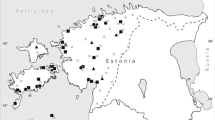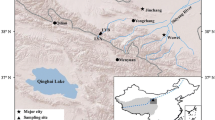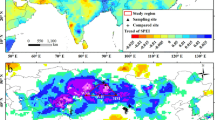Abstract
For over a decade, the Hopi Tribe and Navajo Nation of northeastern Arizona have suffered the effects of persistent drought conditions. Severe dry spells have critically impacted natural ecosystems, water resources, and regional livelihoods including dryland farming and ranching. Drought planning and resource management efforts in the region are based largely on the instrumental climate record, which contains a limited number of severe, sustained droughts. In this study, a new network of moisture-sensitive tree-ring chronologies provides the basis for evaluating the longer-term temporal variability of precipitation in the Four Corners region. By analyzing the earlywood and latewood components within each annual tree ring, we are able to generate separate, centuries-long reconstructions of both cool- (October-April) and warm-season (July-August) precipitation. These proxy records offer new insights into seasonal drought characteristics and indicate that the instrumental record fails to adequately represent precipitation variability over the past 400 years. Through the use of two different analysis techniques, we identify multiyear and decadal-scale drought events more severe than any in the modern era. Furthermore, the reconstructions suggest that many of the historically significant droughts of the past (e.g., 17th century Puebloan drought) were not merely winter phenomena, but persisted through the summer season as well. By comparing these proxy records with historical documents, we are able to independently validate the reconstructions and better understand the socioeconomic and environmental significance of past climate anomalies on the tribal lands of northeastern Arizona.



Similar content being viewed by others
References
Adams DK, Comrie AC (1997) The North American monsoon. B Am Meteorol Soc 78:2197–2213
Benson LV, Petersen K, Stein J (2007) Anasazi (pre-Columbian Native American) migrations during the middle-12th and late-13th centuries—were they drought induced? Clim Chang 83:187–213
Biondi F, Kozubowski TJ, Panorska AK (2002) Stochastic modeling of regime shifts. Clim Res 23:23–30
Box GEP, Tiao GC (1975) Intervention analysis with applications to economic and environmental problems. J Am Stat Assoc 70:70–79
Bradfield M (1971) The changing pattern of Hopi agriculture. Royal Anthropological Institute, London
Brugge DM (1994) The Navajo-Hopi land dispute: an American tragedy. University of New Mexico Press, New Mexico
Cable DR (1975) Influence of precipitation on perennial grass production in the semidesert Southwest. Ecology 56:981–986
Christensen JH, Hewitson B, Busuioc A et al (2007) Regional climate projections. In: Solomon S et al (eds) Climate change 2007: the physical science basis. Contribution of working group I to the fourth assessment report of the intergovernmental panel on climate change. Cambridge University Press, Cambridge and New York, pp 847–940
Cleaveland MK (1986) Climatic response of densitometric properties in semiarid site tree rings. Tree-Ring Bull 46:13–29
Comstock JP, Ehleringer JR (1992) Plant adaptation in the Great Basin and Colorado plateau. West N Am Nat 52:195–215
Cook ER, Peters K (1981) The smoothing spline: a new approach to standardizing forest interior tree-ring width series for dendroclimatic studies. Tree-Ring Bull 41:43–51
Cook ER, Seager R, Cane MA, Stahle DW (2007) North American drought: reconstructions, causes, and consequences. Earth Sci Rev 81:93–134
Cook ER, Seager R, Heim RR Jr, Vose RS, Herweijer C, Woodhouse C (2010) Megadroughts in North America: placing IPCC projections of hydroclimatic change in a long-term palaeoclimate context. J Quaternary Sci 25:48–61
Daly C, Halbleib M, Smith JI, Gibson WP, Doggett MK, Taylor GH, Curtis J, Pasteris PP (2008) Physiographically sensitive mapping of climatological temperature and precipitation across the conterminous United States. Int J Climatol 28:2031–2064
D'Arrigo RD, Jacoby GC (1991) A 1000-year record of winter precipitation from northwestern New Mexico, USA: A reconstruction from tree-rings and its relation to El Niño and the Southern Oscillation. Holocene 1:95–101
Dean JS (1988) Dendrochronology and palaeoenvironmental reconstruction on the Colorado Plateaus. In: Gumerman GJ (ed) The Anasazi in a changing environment. Cambridge University Press, New York, pp 119–167
Donaldson TC (1893) Moqui Pueblo Indians of Arizona and Pueblo Indians of New Mexico. United States Census Printing Office, Washington
Douglas MW, Maddox R, Howard K, Reyes S (1993) The Mexican monsoon. J Clim 6:1665–1667
Douglass AE (1914) A method of estimating rainfall by the growth of trees. B Am Geogr Soc 46:321–335
Eakin H, Conley J (2002) Climate variability and the vulnerability of ranching in southeastern Arizona: a pilot study. Clim Res 21:271–281
Ferguson DB, Alvord C, Crimmins M, Redsteer MH, McNutt C, Hayes M, Svoboda M, Pulwarty R (2011) Drought preparedness for tribes in the Four Corners region. Climate Assessment for the Southwest. http://www.climas.arizona.edu/publications/2085. Accessed 19 March 2012
Fritts HC (1976) Tree rings and climate. Academic, London
Gray ST, Jackson ST, Betancourt JL (2004) Tree-ring based reconstructions of interannual to decadal scale precipitation variability for northeastern Utah since 1226 AD. J Am Water Resour Assoc 40:947–960
Griffin D, Meko DM, Touchan R, Leavitt SW, Woodhouse CA (2011) Latewood chronology development for summer moisture reconstruction in the US Southwest. Tree-Ring Res 67:87–101
Hackett CW (1937) Historical documents relating to New Mexico, Nuevo Vizcaya and approaches thereto, to 1773. Carnegie Institution of Washington Publication, Washington DC
Hereford R, Webb R (1992) Historical variations of warm-season rainfall, southern Colorado Plateau, southwestern U.S.A. Clim Chang 22:239–256
Hoover JW (1930) Tusayan: the Hopi Indian country of Arizona. Geogr Rev 20:425–444
Knaut AL (1997) The Pueblo revolt of 1680: conquest and resistance in seventeenth-century New Mexico. University of Oklahoma Press, Oklahoma
Knutson CL, Hayes MJ, Svoboda MD (2007) Case study of tribal drought planning: the Hualapai Tribe. Nat Hazards Rev 8:125–131
Levy JE (1992) Orayvi revisited: social stratification in an “egalitarian” society. School of American Research Press, Santa Fe
Meko DM, Baisan CH (2001) Pilot study of latewood-width of conifers as an indicator of variability of summer rainfall in the North American monsoon region. Int J Climatol 21:697–708
Michaelsen J (1987) Cross-validation in statistical climate forecast models. J Appl Meteorol 26:1589–1600
National Drought Mitigation Center (NDMC) (2006) Developing a drought plan: The Hopi Nation. National Drought Mitigation Center. http://drought.unl.edu/plan/HopiPlan.htm. Accessed 18 March 2012
Navajo Nation Department of Water Resources (NNDWR) (2003) Navajo Nation drought contingency plan. Navajo Nation Department of Water Resources. http://www.dnr.navajonsn.gov/Drought/images/drought_pln2003.pdf. Accessed 18 March 2012
Parks JA, Dean JS, Betancourt JL (2006) Tree rings, drought, and the pueblo abandonment of south-central New Mexico in the 1670 s. In: Doyel DE, Dean JS (eds) Environmental change and human adaptation in the ancient American southwest. University of Utah Press, Salt Lake City, pp 214–227
Pederson GT, Gray ST, Fagre DB, Graumlich LJ (2006) Long-duration drought variability and impacts on ecosystem services: a case study from Glacier National Park, Montana. Earth Interact 10:1–28
Ray AJ, Garfin GM, Wilder M, Vásquez-León M, Lenart M, Comrie AC (2007) Applications of monsoon research: opportunities to inform decision making and reduce regional vulnerability. J Clim 20:1608–1627
Rose MR, Dean JS, Robinson WJ (1981) The past climate of Arroyo Hondo, New Mexico reconstructed from tree rings. School of American Research Press, Santa Fe
Salas JD, Delleur JW, Yevjevich V, Lane WL (1980) Applied modeling of hydrologic time series. Water Resources Publications, Littleton
Salzer MW, Kipfmueller KF (2005) Reconstructed temperature and precipitation on a millennial timescale from tree-rings in the Southern Colorado Plateau, USA. Clim Change 70:465–487
Sauer CO (1980) Seventeenth century North America. Turtle Island, Berkeley
Schwinning S, Belnap J, Bowling DR, Ehleringer JR (2008) Sensitivity of the Colorado Plateau to change: climate, ecosystems, and society. Ecol Soc 13:28–47
Sekaquaptewa H (1969) Me and mine: the life story of Helen Sekaquaptewa. University of Arizona Press, Tucson
Sheppard PR, Wiedenhoeft A (2007) An advancement in removing extraneous color from wood for low-magnification reflected-light image analysis of conifer tree rings. Wood Fiber Sci 39:173–183
Sheppard PR, Comrie AC, Packin GD, Angersbach K, Hughes MK (2002) The climate of the US Southwest. Clim Res 21:219–238
St. George S, Meko DM, Cook ER (2010) The seasonality of precipitation signals encoded within the North American drought Atlas. Holocene 20:983–988
Stahle DW, Cleaveland MK, Grissino-Mayer HD et al (2009) Cool- and warm-season precipitation reconstructions over western New Mexico. J Clim 22:3729–3750
Stephen AM (1936) The Hopi journals of Alexander M Stephen. Columbia University Press, New York
Therrell MD, Stahle DW, Cleaveland MK, Villanueva Diaz J (2002) Warm season tree growth and precipitation over Mexico. J Geophys Res 107:4205–4213
Titiev M (1944) Old Oraibi: a study of the Hopi Indians of the Third Mesa. Kraus Reprint, New York
Touchan R, Woodhouse CA, Meko DM, Allen C (2011) Millennial precipitation reconstruction for the Jemez Mountains, New Mexico, reveals changing drought signal. Int J Climatol 31:896–906
Weiss JL, Castro CL, Overpeck JT (2009) Distinguishing pronounced droughts in the southwestern United States: seasonality and effects of warmer temperatures. J Clim 22:5918–5932
Woodhouse CA (2003) A 431-yr reconstruction of western Colorado snowpack from tree rings. J Clim 16:1551–1561
Woodhouse CA, Meko DM, MacDonald GM, Stahle DW, Cook ER (2010) A 1,200-year perspective of 21st century drought in southwestern North America. Proc Natl Acad Sci USA 107:21283–21288
Acknowledgements
This work was supported by the National Oceanic and Atmospheric Administration’s Climate Program Office through grant NA07OAR4310382 with the Climate Assessment for the Southwest program at the University of Arizona, and by National Science Foundation award number 0823090. We are grateful to personnel of the U.S. National Park Service and to the Navajo Nation for facilitating tree-ring sampling on federal and tribal lands. Thanks to Tom Sheridan and Dale Brenneman for inspiring the use of historical documents, and to Daniel Ferguson and Alison Meadow for facilitating Hopi stakeholder collaboration. Many thanks to Paul Sheppard, Michael Crimmins and two anonymous reviewers for providing constructive feedback that improved this manuscript.
Author information
Authors and Affiliations
Corresponding author
Electronic supplementary material
Below is the link to the electronic supplementary material.
ESM 1
(DOCX 584 kb)
Rights and permissions
About this article
Cite this article
Faulstich, H.L., Woodhouse, C.A. & Griffin, D. Reconstructed cool- and warm-season precipitation over the tribal lands of northeastern Arizona. Climatic Change 118, 457–468 (2013). https://doi.org/10.1007/s10584-012-0626-y
Received:
Accepted:
Published:
Issue Date:
DOI: https://doi.org/10.1007/s10584-012-0626-y




